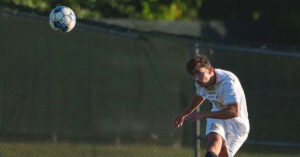
Managing NIL in a better, more uniformed way.
By Mason Jones, Kamryn Eskew, and Elizabeth Conley
Just imagine this. You play college soccer for the Indiana Hoosiers and are in the middle of the championship match. You are a forward. It is a cool, autumn Thursday evening at Indiana University and you and your team are playing against the Clemson Tigers. The smell of the damp ground fills the air as you breathe deeply. The score is tied at 1-1, and you are up to take the game-winning penalty kick. The stadium is filled with students, families, and children screaming and shouting, but in your mind, it is silent. Nothing is more important than this moment. A deep inhale of oxygen is taken, followed by a slow exhale. After taking three steps backward, your cleats dig into the grass, and your eyes are glued to the soccer ball on the ground. You then run towards the ball and kick it. The ball goes left towards the goal, but the goalie leaps to the right, missing it. The crowd roars and your teammates are running towards you. The Indiana Hoosier’s soccer team just won the championship game because you made the penalty kick. Ever since that moment on that night, your name and face have been everywhere. As a sophomore athlete at Indiana University, you have been the best player on the team and have had many outstanding performances during games. Still, after you made the championship game-winning penalty kick, your image has soared through the media. You are no longer one of the most famous college athletes in the country, but now the most famous athlete. Growing up, being a professional soccer player was your dream, but you never imagined being this big in the NCAA. Stress and anxiety begin to overtake you as you think about how much pressure you have gotten from being all over the internet, and you worry about how it will affect you. A question lingers in your mind: “Is there a way to handle my image without the stress and pressure?”
In June 2021, the Supreme Court allowed college athletes to finally benefit from their name, image, and likeness, also known as NIL, which changed college sports. In a unanimous 9-0 decision, the Supreme Court upheld the lower court’s decision that NCAA restrictions on “educated-related benefits” for college athletes violated the antitrust laws.

When former high school cross country runner and baseball player Gunner Jones was asked about his general thoughts on NIL in the NCAA, he expressed that there are positive benefits from it, while also being mishandled. “NIL in today’s college sports is a good thing, but it has just been mishandled,” he said. “I do believe that student athletes are entitled to make money off of their name, image and likeness, but I also believe that there has to be regulations and rules set in place in order to protect the student athlete.”
“I do believe that more successful athletes do have a right to negotiate better terms and have larger NIL,” Jones said.
It was also important to know what a college athlete’s thoughts on the topic were. Jackson Kelsey, a former high school soccer player, track runner, swimmer, and football player, played soccer for Manchester University, located in Indiana. He transferred from Manchester University to Indiana University but does not play for the Hoosiers’ soccer team. The financial aspect of NIL is a big part of what keeps them going. “I think NIL is a great way for athletes to receive compensation beyond scholarships,” Kelsey said. “It gives student athletes an opportunity to profit from their own personal grants… Money can get in the way of college sports spirit, and I think, to an extent, it takes away the element of amateurism that is college sports.”

Kelsey also talked about his thoughts on how to better manage an athlete’s NIL. “I think there needs to be clear guidelines on the rules around NIL to ensure fairness and compliance,” he said. “While the management is sort of all over the place right now, I do think with the NCAA v. House Case, we will start to see a more uniformed system.”

Indiana University’s Media School Associate Dean, Galen Clavio is an expert at NIL and when it comes to athletes earning money from other companies besides the university. “The NCAA is trying very much to put legal protections in that would allow them to essentially operate a financial monopoly…by making them the sole distributor of money,” Clavio said. So, there is always competition for colleges with a talented athlete who is getting many brand deals.
Overall, NIL has improved the lives of many college athletes. It gives them a sense of belonging in their sport, while giving them financial benefits.
On the topic of NIL, we asked a couple members of the IU community their opinion. They shared their thoughts on the topic of managing NIL in a better way.
###

